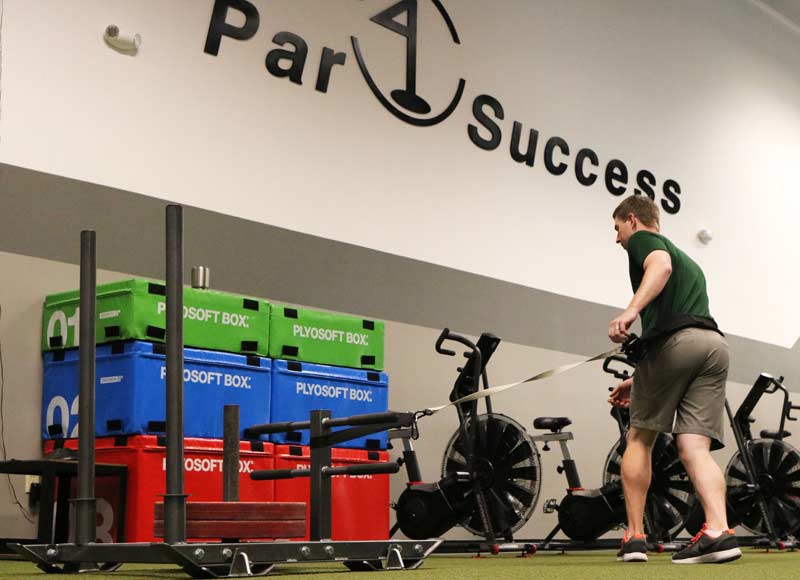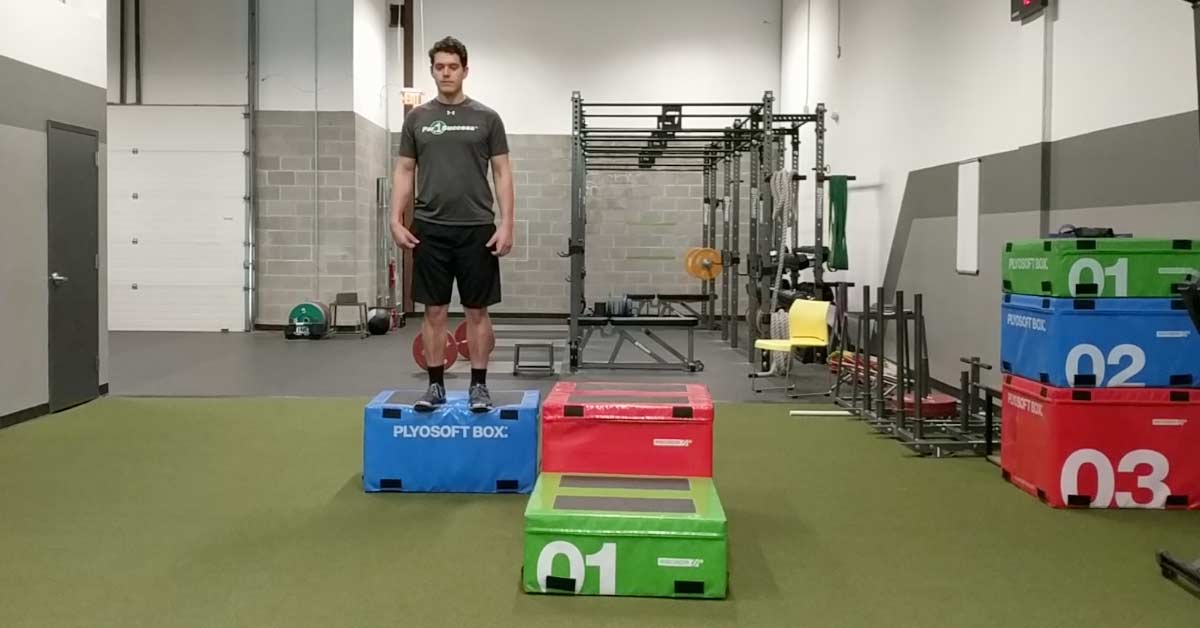[mashshare]
Strength and core training in golf is much like the game itself—traditional and steeped in years of “we do it this way because that’s how we’ve always done it” thinking. The uptick in sports science being done in the field has challenged that belief in recent years. This comes at a time when the young stars of the game are defying many of its old ideas: from fashion to etiquette to what really matters when it comes to cashing a check.
The last couple of years of stats on the PGA and LPGA tours have proven that the age-old saying of “Drive for show and putt for dough” is inherently wrong. The updated saying for 2020 is now: “Drive for show and cash checks for millions.”
These seven types of training and exercises are valuable in golf performance training but are often left out of traditional golf fitness plans. Share on XWhat follows are seven exercises and types of training shown to be valuable in golf performance training, but often left out of traditional golf fitness plans. These are things that Arnold Palmer, Gary Player, and even Tiger Woods had no idea about in their primes. In fact, many of the top Tour players and their trainers are still discovering the value and place that these seven critical elements hold in the best performance plan for a golfer.

kPulley Straight Arm Rotation
Rotational training is nothing new in core or strength training for golf. It has been around since the invention of training for the game. Medicine balls, bands, cables, and anything else you can hold while you rotate are all used to “train the core” for better separation in the golf swing. “Without a strong core you can’t create separation” is a common saying you will hear from a trainer whenever they work with a golfer. While we don’t know if it is true, we do know that if we train rotation with a specific intent, we can produce 150% better gains in swing speed than seen in traditional rotational training.
The kPulley is a machine that helps coaches train golfers with rotational eccentric overload in a way that has not been available in the past. The flywheel and Bluetooth outputs allow a coach to train different traits of a golfer, from speed to power and many things between.
The straight arm rotation was the exercise we used in our 2018 study, which demonstrated 150% more swing speed gains in golfers in six weeks compared to just using bands or cables in the traditional way. Raw numbers, for perspective, were a 2.5 mph gain compared to a 1 mph gain, which equates to about a 5-yard difference in gain off the tee.
Video 1. This exercise is more stabilization and strength than power. Using a bar enables an athlete to focus on the trunk rather than using the upper body too much.
The straight arm rotation on the flywheel offers a couple of options to the coach in terms of sequencing and ground force applications that can be trained depending on the goals of the exercise. If straightforward rotational “core strength” is the goal, having the athlete stand while keeping the hips straight forward and just moving the upper body is a way to isolate the upper half and be able to load the pattern with upward of 30% overload eccentrically, as we have seen in training. This would obviously require lower body stabilization and separation of the lower and upper halves.
If a coach wants a more athletic-looking movement that is similar kinematically to the golf swing, another approach to take with this exercise is to have both the upper and lower body moving through, with active use of the lower body to assist with the rotational horizontal pull. The benefits of taking this approach also include the opportunity to coach the athlete on proper use of the ground with a focus on load and horizontal drive initially off the instep of the trail foot and then working into torsional (and even vertical drive, if desired) as each repetition is completed.
Five yards gained off the tee using this exercise is massive compared to traditional methods employed more predominantly in golf today. Share on XThe coach can best decide when and how to use this exercise with the overall program in mind; however, I cannot understate the benefit of this exercise. Five yards gained off the tee when this exercise was specifically used is massive compared to traditional methods employed more predominantly in golf today.

kPulley Wrap Low to High
The strap that wraps around a golfer or other rotational athlete has been around for a while now. Its popularity is spreading mostly via social media campaigns and higher profile athletes utilizing it in various social media posts. Beyond that, however, the use of a strap-wrap to drive performance gains continues to remain on the sidelines of traditional golf performance programs. When coaches utilize it, they’ve brought it in for variety’s sake or to combat boredom by athletes here or there; it doesn’t often have a targeted performance-based purpose.
I will contend that while the strap has value, as I will discuss shortly, the real value in this exercise is in what the strap connects to. This is why we utilize it with the kPulley with our golfers.
Video 2. Rotation and twisting can become difficult to differentiate in real-life. Using a strap with solid leg drive is an awesome overload option for golf and other sports.
As described with the horizontal rotational pull, the eccentric flywheel proved to produce superior results to the traditional tools of bands and cables when it came to creating gains that transferred to the sport because of the eccentric overload opportunity that the device offers. For this reason, we aim to utilize the eccentric flywheel whenever we can with our rotational strength training work.
The other added value that we have seen with the use of the flywheel along with the wrapped strap is the increased opportunity as a coach to have your athlete focus on how they kinetically use the ground. Because they do not have their arms connected to anything, the only way that they are able to create movement is by using their legs. This becomes their only focus, and when coaching it, you can really help them tune into how they use the ground.
Most golfers sequence kinetically from horizontal to torsional and then finish vertically. This is how we look to cue our golfers to move when they use this exercise in their program. Even more helpful, though, is that if your player needs to work on more horizontal force creation, then you can help cue that. Move the connection to the flywheel higher so it is more at the hip level as opposed to truly low, like when you might want to train more vertical drive at the end.
Finally, as a coach, you can also look to train the athlete to focus on improved impulse on each repetition. This is becoming a buzzword in the golf world these days with some recent research findings, and rightfully so. The better the impulse a golfer is able to create, the faster their club speed will be. Helping them to work on getting to their maximal power output on each rep as fast as they can, as opposed to a long low-level ramp-up, is also a very important skill to focus on during this exercise.

Hop Back Iron Man Throw
Iron Man throws are not necessarily a new concept in the golf strength and conditioning world. The idea of when to use a hop back variation versus a standard throw versus a step behind variation versus a dropdown variation, however, is not so common in progressive and periodized programming, traditionally.
When looking at the types of training that are most effective for golfers across the age spectrum throughout their careers, triphasic training has shown to be very effective for golfers in their adult and senior years. That being said, it would make sense to periodize the plyometric/impulse training-focused exercises to progress through a triphasic program along with a strength component.
A hop back variation of an Iron Man throw is a great way to train a golfer’s ability to absorb and store force during an eccentric phase. It is also a great way to start to help the golfer understand what it means to load and use the ground correctly. Many times, we see golfers roll to the outside of their trail foot the first few times they try this exercise. We also see them fail to get down “into” their trail hip, leading to them “floating” through the throw. They are not able to use the ground appropriately, and this leads to significant decreases in how they create force.
Video 3. The Hop Back Iron Man Throw isn’t common, but the benefits are more than they appear. This demonstration shows controlled use of the hip, and as athletes progress, the speed can increase as well.
When measured on force plates, we have noted that how you coach the athlete to load directly impacts the kinetic sequence as well as the magnitude of ground force that is created in significant ways. We cannot understate the importance of the athlete’s focus on the quality of how they use the ground during this exercise.
I cannot understate the importance of the athlete’s focus on the quality of how they use the ground during the hop back Iron Man throw exercise. Share on XThe lack of this and other variations of medicine ball exercises being used incorrectly in traditional golf performance training are both, in my opinion, due to a severe dearth of understanding in how to use medicine ball throws with maximal efficiency. There have been a number of SimpliFaster articles on the optimal use of medicine ball training and the importance of periodizing medicine ball use throughout the year.
Unfortunately, more often than not, medicine ball throws such as the Iron Man throw are included to fill time rather than achieve a training goal need. If you can think about what the variation of the throws attempts to accomplish from a kinetic standpoint as well as a training system standpoint, it starts to become more apparent when and where to use them for maximal results.

Drop Rotational Box Jump
As mentioned in the Iron Man hop back variation, improving a golfer’s impulse is paramount for them to be able to produce more club head speed when they compete. The Iron Man variations allow for single leg focuses and are probably more “sport movement specific,” as they tend to mimic the way a golfer specifically moves in the golf swing. That being said, we all know that training does not have to look like the golf swing to be extremely helpful and transferrable.
The drop rotational box jump puts the golfer in an environment where both legs have to absorb force and then express it out as quickly as possible, with a torsional and horizontal component to rotate 90 degrees and land on the box to the side of them. This will lead to greater force generation and is generally easier to introduce from a coordination standpoint than a dropdown Iron Man throw.
As the athlete progresses, changing the height of the drop box as well as the height of the box they have to land on (if there’s one at all) allows the coach to manipulate the exercise based on the appropriate training goals for the athlete and where they are in their training.
One of the most common things that we see in traditional golf fitness programs is the misuse of box jumps and other jumps, similar to how medicine balls are used. You don’t have to look far to see golfers and others in the golf fitness industry touting how high they or their athletes can jump onto a box.
Video 4. Due to the planned motion, the exercise is safer than it sounds. Regardless, coaches need to program this only when the athlete is ready.
There are two common issues at play here. The first is the basic understanding of why we would program a box jump in the first place. Box jumps should be used to train improved impulse magnitude and, if we use a drop, to decrease the time of that impulse as well as the amount of force the system has to absorb. A higher box is easier for the system, not harder.
If an athlete has a vertical jump of 24 inches, then jumping and landing on a 30-inch box means that they have to flex their hips up at least 6 inches to land the jump. That is a negative 6-inch absorption of load. If, however, that same athlete steps off a 30-inch box and has to stick the landing, they just had to absorb way more load. So, which is more helpful? It depends.
If you want to decrease the load acceptance requirement for an athlete, a higher box jump is where you want to go. If, however, you want to maximally train an athlete for force absorption and impulse improvement, a drop jump is where you want to be. Understanding what the exercise accomplishes allows a coach and an athlete to start to figure out where and why it belongs in training. Without this first part, the second is impossible.
Higher definitely looks cooler for social media posts, but accepting load when dropping down off a box is definitely more challenging for the athlete’s system. Share on XThis confusion over which type of box jump is “harder” might be the biggest misunderstanding that I see in training golfers on a daily basis. Higher definitely looks cooler for social media posts, but accepting load when dropping down off a box is definitely more challenging for the athlete’s system.

Velocity-Based Resistance Training
Velocity-based programming or training, depending on who you talk to and what they like to call it, is definitely not traditional by any stretch of the imagination. It is relatively new, in general, and we all know that golf is not known for being at the forefront of anything when it comes to strength and conditioning. It shouldn’t shock you that velocity-based training is not traditionally in a golf-specific training program.
The apparent value of this type of training is becoming more and more obvious in the research and in practice. The idea that you essentially have a leading fatigue metric every day an athlete comes in to train that will self-regulate their load to keep them in the range you want them to train is extremely appealing. While it is a mind shift for any coach or athlete used to percentage-based training, it is one that comes relatively quickly and shouldn’t be a barrier to adoption.
One of the bigger logistical barriers is the need to assess athletes to determine their individual profiles for each lift. In golf, however, this is much less of a barrier, as golfers are individual athletes, and we don’t run into the issues that large football or other team sports do where a coach needs to profile 40+ athletes. Even at the collegiate level, where golf is a team sport, there are rarely more than 10 athletes, which makes it not an issue logistically.
In a recent article published by Dorrell and colleagues1, there was a noted, significant improvement in strength and countermovement jump performance despite the group using velocity-based training having done less volume. The authors commented on the potential value of this for managing fatigue of athletes during competitive seasons. With golf at the professional levels being essentially a year-round sport at this point, this is a huge finding and potential benefit for golfers.
There is still an obvious barrier to the inclusion of this type of training in golf on a large scale. The travel that occurs during the long season means that athletes at the professional level do not have access to barbells and/or the technology all the time, making year-round use of this type of training challenging sometimes. That being said, the wearable market for velocity-based training is improving in its accuracy and ability to produce reliable readings for athletes to use it on the road when they travel.
As the research and the benefits of this training become more defined and the technology continues to improve, I would not be surprised if velocity-based programming and training starts to trend as the “norm” more than anything else on this list.

Lateral Sled Pulls
Sleds are not often used in traditional golf performance training as it is, never mind a lateral pull variation. The benefit of this type of pull is that it requires increased use of the adductor muscle group. This is an extremely difficult group of muscles to train in an explosive manner in the gym. As such, despite it being one of the most important muscle groups in the golf swing, particularly on the lead side of the golfer, traditional strength and conditioning programs for golf performance often overlook it.
The exercise challenges the athlete to extend the hip with adduction, which is the exact movement that the lead hip completes during the golf swing. You can vary the load depending on what attributes you are looking to train (strength vs. power vs. metabolic, etc.).

We utilize lateral sled pulls in our programs throughout the year with our athletes, but we do so differently, depending on where they are in their season and what the overarching goal of their training program is at that time. For instance, in the early off-season, we utilize the lateral sled pulls but with a focus on metabolic goals to build a base or capacity for the upcoming season. We utilize different variations of workouts from low load, low recovery to pyramid schemes, and everything in between.
When we get into the middle of the off-season, we often utilize this exercise as part of a superset on a low neural day to continue to challenge capacity while it is okay for volume to be higher. As their program progresses toward later off-season, and we concentrate on impulse magnitude and duration for maximal power output, lower volume with good power output and longer rests becomes more of a focus.
When the athlete is in season, we apply this specific exercise as a bit of a warm-up to make sure we train that pattern and keep it clean, but we don’t put a ton of stress on their system with it. They are playing and traveling so much that we focus more on the compound movements for our big power outputs and consider this an auxiliary lift at this point in their programming.
The biggest barrier to the mass adoption of lateral sled pulls in traditional programs is the access to turn and/or sleds as well as a long-enough runway to make it worthwhile. Share on XThe biggest barrier to mass adoption of this exercise in traditional programs is the access to turf and/or sleds as well as a long-enough runway to make it worthwhile for the athlete. Particularly when athletes are on the road, finding gyms with this equipment can be tough. When you are able to find a facility that provides the opportunity to implement this exercise, however, go for it. You’ll be happy you did.

Triphasic Strength Training
This is not a specific exercise, but rather a type of training that has been found to be helpful to drive clubhead speed gains in older golfers. In adult golfers, a gain in club speed of more than 50% was seen when the subjects utilized triphasic training as opposed to traditional training (progressive load without tempo considerations). The opposite effect was actually seen in junior golfers, which is interesting to note.
In the study outlined below, a four-week phase focusing on 5- to 7-second descent followed by a four-week phase focusing on a 5- to 7-second isometric hold at the bottom of each rep flowed into a four-week conversion to power phase. Because of the increased time under tension in the first two phases, the adult and senior golfers used lower loads to achieve the results of the increased club speed than the traditional training groups. Subjectively, the individuals were much more comfortable with less load on their bodies and, as such, self-reported enjoying the program.
When using triphasic training, we have also found it productive to periodize rotational work such as medicine balls, cable/flywheel rotational exercises, and jump training. As mentioned earlier in this article with the different Iron Man variations, utilizing hop back variations during the eccentric phases to focus on storing energy and progressing to step behind or drop variations during the conversion to power phase improves impulse magnitude and decreases duration.
Video 5. Eccentric tempo work is timeless and popular for a reason. Controlling the eccentric portion of the lift offers a great foundation before advancing to maximal and rapid overload options.
There are no barriers to using this type of training like there are with some of the other exercises or VBT mentioned above. The only thing needed to utilize this type of training with your athletes is for them to be able to count to five correctly. It is simple to implement triphasic training on the road, and athletes pick up on how and why they should implement it very quickly.
Keep Pushing Our Athletes, and the Field, Farther
The golf fitness and performance industry is progressing in leaps and bounds every year, and that is nothing but great for the game and the athletes who play it. As demonstrated above, there is still a high ceiling that we can reach for to continue to push our field and our athletes even farther.
As technology & research continue to make available new methods and modalities, coaches need to continue to educate ourselves on what’s worthwhile to share with our athletes. Share on XThe common thread here is to utilize each of these seven exercises or strategies first with an understanding of why you would use it with an athlete and why that athlete would potentially benefit from it. Then, we need to be crystal clear as to where it fits in their program and when it would be most beneficial for them to achieve transferrable results on the golf course. Finally, as technology and research continue to push forward and make available modalities and methods that were not available before, coaches need to continue to educate ourselves on what exists and is worthwhile to share with our athletes.
The future is bright for golfers and their ability to continue to perform at levels never before thought possible. These are only seven of the many elements that will continue to become more and more mainstream over the next decade as “traditional” continues to be redefined on an almost daily basis.
Since you’re here…
…we have a small favor to ask. More people are reading SimpliFaster than ever, and each week we bring you compelling content from coaches, sport scientists, and physiotherapists who are devoted to building better athletes. Please take a moment to share the articles on social media, engage the authors with questions and comments below, and link to articles when appropriate if you have a blog or participate on forums of related topics. — SF
[mashshare]
References
1. Dorrell, H. F., Smith, M. F., & Gee, T. I. (2020). Comparison of velocity-based and traditional percentage-based loading methods on maximal strength and power adaptations. Journal of Strength and Conditioning Research, 34(1), 46.




